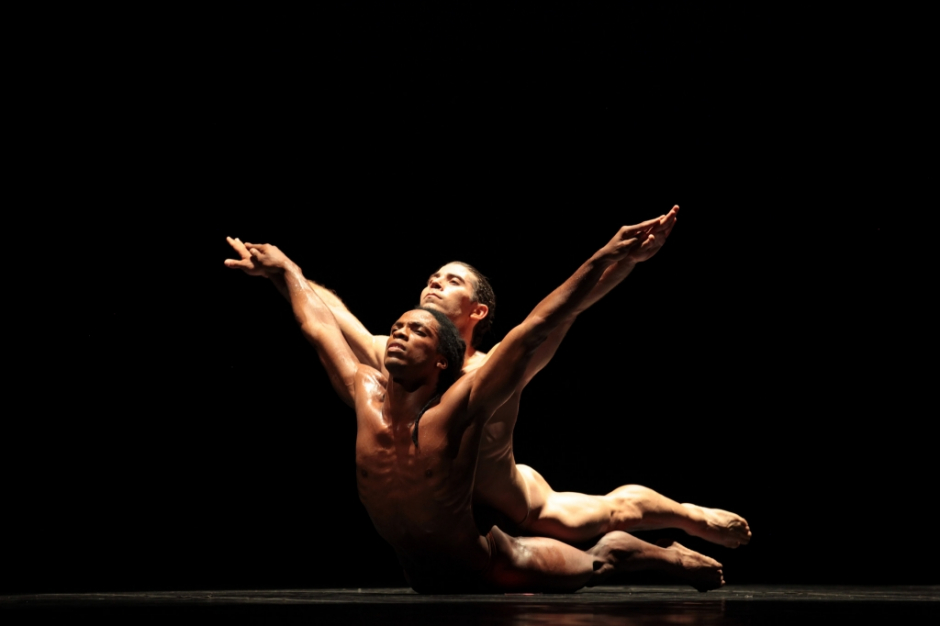Acosta Danza, produced by Sadler’s Wells and Valid Productions; The Lowry, 12 October 2017.
Carlos Acosta has used his fame and popularity a ballet dancer to turn the spotlight towards the next generation of Cuban dancers through his company Acosta Danza. Their first UK tour brings a taster of their talent and distinctively playful approach to work from new choreographers. Acosta himself appeared for a duet with Marta Ortega, but the evening was dominated by the younger dancers, making sure that all got a share of attention.
The first piece, El Cruce Sobre El Niágara (The Crossing Over Niagara), was choreographed by Marianela Boán and asserted the physical strength of the dancers as Carlos Luis Blanco progressed slowly across the stage to the lying body of Alejandro Silve. The costumes left little to the imagination, showing the full strength of the dancers as they moved from one muscular pose to another. The meeting of the dancers prompted a faster, more vigorous section of the dance, where the two tested each other’s strength and balance. The dancers gradually worked more and more together, finishing by walking into the sunset as together as it’s possible to be, gradually complementing and doubling each other through the dance. The choreography was somewhere between the most beautiful and difficult yoga class you have ever seen, and the muscular depictions of ancient Greek athletes, and was mesmerising to watch.
The second piece, Belles-Lettres, was choreographed by Justin Peck for nine dancers, with a much more fluid and light style than the previous piece. The dancers formed couples, groups, and danced individually, some more successfully than others. Some of the pairings in particular seemed to leave their moves a little lacklustre, or not to be entirely certain where each other were. I was excited to see Peck’s work, and this piece was very enjoyable to watch but was so light it became forgettable among the more aggressively focused pieces that made up the rest of the evening.
After the interval, Imponderable offered a dystopian image, with all the dancers in uniform black and lifting, dropping, and trapping each other as they move around the stage. The songs of Silvio Rodruguez, reinterpreted by Owen Belton, punctuate the piece and create moments where all the dancers come together and move en masse, with the look and feel of a workout music video. The piece felt a little over-long though and lost focus as it went on, with sections lit by torches held by the dancers feeling a little contrived. When the lights came up for the bows the dancers’ costumes were revealed to be far more interesting than they had looked in the partial lighting of the dance, and the pleats and textures suggested more interesting potential.
Mermaid, choreographed for Acosta and Marta Ortega by Sidi Larbi Cherkaoui, was a peaceful moment with just the two dancers lit simply as they interacted with a kind of tenderness and patience. The piece allows for the more mythical interpretations suggested by its title, though it often looks more like Acosta guiding home Oretega as a woman too drunk to walk and too exuberant to care. Ortega’s tentative movements displayed precision and focus after the confusion of Imponderable, and her uncomfortable walking connects pointe shoes with the pain of Andersen’s Little Mermaid, as she walks on her new feet for the first time.
The final piece, Twelve, is a “dance-sport piece” that is both an engrossing spectacle and disconcertingly like playground games. The dancers throw, catch, arrange, rearrange, and throw again a collection of water bottles containing glowing light sticks. It is a piece that needs to be seen more than to be described, and was an exuberantly playful way to end the evening that summed up the approach of the company – fun, experimental, looking to create spectacles that drag in the audience’s emotions.
The evening offered a good balance between the spectacular group pieces and more intimate and peaceful moments where two dancers to interact with precision and sensitivity. Acosta described in the post-show Q&A wanting the evening to offer an emotional arc, with something for everyone, and that was certainly achieved, though at moments perhaps the virtuosity of the dance was sacrificed to this goal. Acosta’s company looks to current and contemporary choreographers to create a relatively experimental programme that is fresh and prepared to take risks with what people expect from a ballet company, while also making a crowd-pleasing evening with a range of emotions and a perfectly pitched finale.

